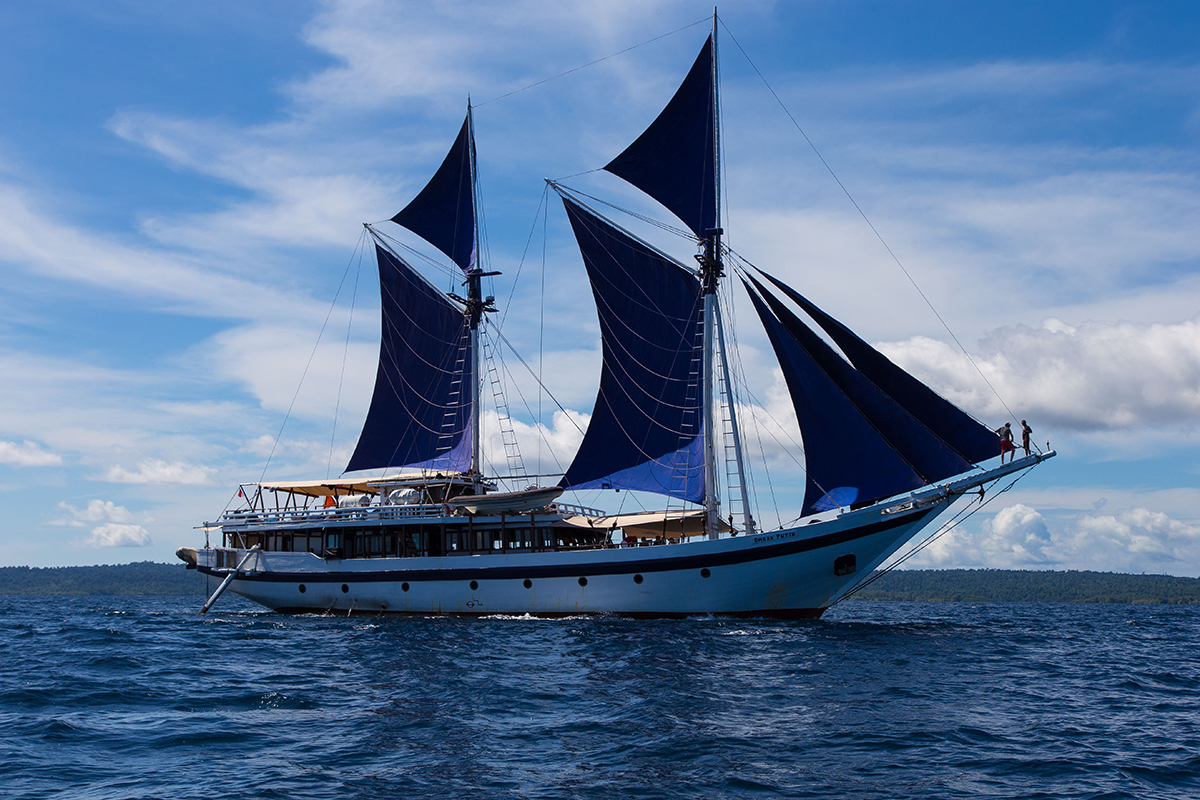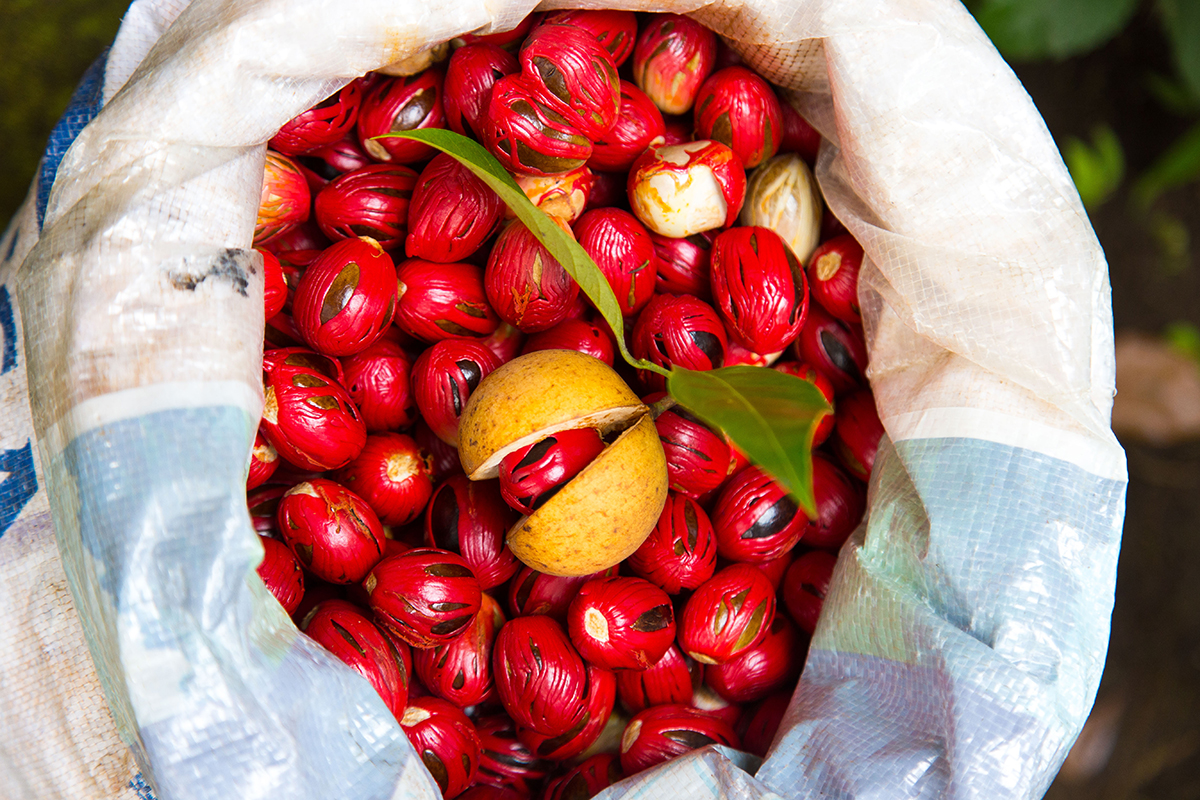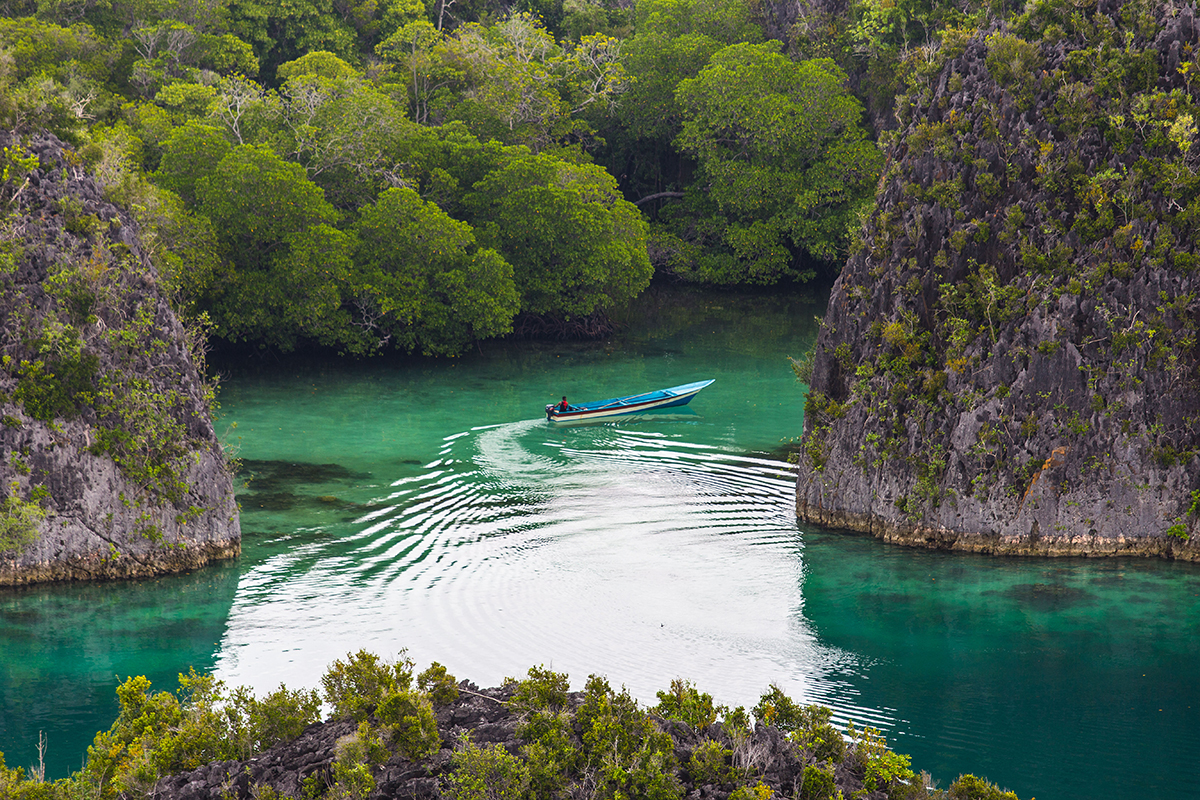This website uses cookies so that we can provide you with the best user experience possible. Cookie information is stored in your browser and performs functions such as recognising you when you return to our website and helping our team to understand which sections of the website you find most interesting and useful.
Snorkel and spice: an expedition to some of Indonesia’s most far-flung islands
By Sarah Freeman | 25 July 2019 | Travel
From nutmeg currency to life on board a traditional ship, this volcanic island cruise has it all

My thalassic home for the next 12 days is a traditional wooden pinisi by the name of Ombak Putih (or white wave), that’s been plying Indonesia’s pristine waters for 20 years. Fitted out with 12 colonial-styled luxury cabins, schooner day beds and a vast deck table for star-lit dining, it’s certainly an upgrade from Victorian naturalist Alfred Russel Wallace’s humble digs, who recalled sleeping “very comfortably with half a dozen smoke-dried human skulls suspended over my head”.
I’m embarking on a journey from Western Papua to the Maluku Islands with SeaTrek, retracing the steps of Wallace who travelled 65,000km in these exotic waters and jungles in the mid 1800s. Over the course of eight years, the British biologist collected 100,000 insects and thousands of mammals and birds, co-discovering natural selection in the process. Our modern day exploration, led by Wallace world expert Dr. George Beccaloni, is inspired by the naturalist’s famous travelogue; The Malay Archipelago, promising all the adventure, minus the headhunters and near-starvation!
Fifty Shades of Green
The intrepid voyage begins in Raja Ampat – a virgin archipelago of some 1,500 islands where the Pacific and Indian Oceans meet, crowned an “oceanic Amazon” for its staggering marine biodiversity. Our first tender experience weaves between Kabui Bay’s jungle-clad, limestone islets towards the Wallace Channel, cockatoos and hornbills soaring overhead.
It’s this very passage between Waigeo and Gam Island where the British naturalist crossed as the first westerner in 1860, describing it as “one of the most singular and picturesque landscapes I have ever seen.” It’s aged well. I trek up to Pianemo viewpoint for ‘the money shot’, gazing down on a smattering of islands cast like jewels across the ocean. >>
Related: Revolutionary Maldives underwater residence allows you to sleep beneath the sea

The crystal clear languid waters lure me in for the first of many snorkels. John (aka Seatrek’s merman) leads our group to an overhang studded with a kaleidoscope of corals. Pygmy seahorses swim around my finger, whilst ghost pipefish mysteriously come into view and schools of blue and yellow fusiliers bask in the current. The nutrient-rich waters of this 300,000-acre marine reserve hold some 540 types of corals and more than 1,000 types of coral fish, making it ten-times richer than the Caribbean.
Nature’s Oddities
Several hours later we wash up on the talcum powder beaches of Miostirairama, littered with driftwood and fallen coconuts, not a plastic bottle in sight. The world’s largest land-dwelling arthropods aka coconut crabs are the sole inhabitants of this tiny castaway isle. One such blue crustacean skins a coconut straight from the tree whilst its comrade cracks one open with its colossal pincers. They join the archipelago’s long list of obscure critters like hairy squat lobsters and giant clams that rest on the bottom of the ocean like sunken treasure, measuring one metre in length.
Fittingly, the heavens open as we make a pilgrimage to Wallace’s place of refuge in Yenbeser village, where he spent six weeks in “pounding rain”. SeaTrek have constructed a faithful replica of the naturalist’s stilted hut, referred to as a “dwarf’s house, just eight feet square” in his travelogue.
Steering further south, Ombak Putih continues to a maze of karst islands called Misool. A dramatic landscape of limestone towers plunge deep into the water, riddled with caves like Tomolol, a sacred grotto that we disappear into, one by one. Flickering head touches illuminate its stalactites and some prehistoric cave paintings; best appreciated floating on one’s back. >>
Related: Luxury cruise makes history offering around the world travel in 245 days

The day concludes with a surreal sunset dip in one of the geologically blessed island’s landlocked saltwater lagoons, which are flooded with hundreds of stingless jellyfish.
Canoes and Courtship
The scenery morphs into volcanic islands as we edge further south to the Bandas, where nutmeg was once worth more than its weight in gold. School children serenade us from Goro Goro’s pier (our second port of call), where wild ginger scents the air. It’s not long before we’re deep in the jungle on the look out for black macaques, trailing a group of villagers hauling a canoe (jukung) carved from a single hollowed tree trunk.
This is just a warm up for the virgin rainforests of eastern Halmahera – a remote island in the Moluccas still inhabited by indigenous communities. After a 3am wake-up call, our group sets out on a muddy trail in the pre-dawn darkness through Aketajawe Lolobata National Park. Our mission: to catch a glimpse of Wallace’s elusive standardwing Bird, the naturalist’s greatest prize which he discovered in 1858.
So far our attempts to see one of the region’s six species of birds of paradise have been fruitless, but our luck is about to change. Raucous calls lead us to a small opening in the forest where our group is finally rewarded with a spectacular courtship display, involving posturing, loud screeching and flashes of iridescent green feathers. The standardwing show may be over after 15 minutes, but the forest continues to hold our attention with giant ornamented butterflies, iridescent beetles and hornbills flapping audibly overhead. >>
Related: Four Seasons Resort Koh Samui on conserving Thailand's rich shoreline

Spice up Your Life
Anchorages don’t get much more scenic than the shores of a 1,715 metre-high active volcano. The epic voyage wraps up on Ternate – the fabled volcanic spice island where Wallace posted his essay on natural selection to Charles Darwin in 1858.
Back on terra firma we visit impressive Fort Oranje, one of several historical relics from the island’s turbulent past. After craning my neck admiring ‘Afu’, the world’s oldest clove tree, I fill my boots with cloves and nutmeg, eventually returning to the scenic harbor front, which still affords the “grand views on every side” that Wallace spoke of.
In today’s ever-fragile planet, it’s heartening to have experienced so many natural wonders that appear unchanged from Wallace’s detailed accounts, 150 years on.
SeaTrek offers a host of cruises through the Maluku and Raja Ampa regions, from October-January, with the next ‘Wallace Trails & Sails with Dr. George Beccaloni’ trip in October.






